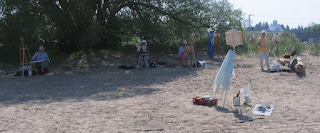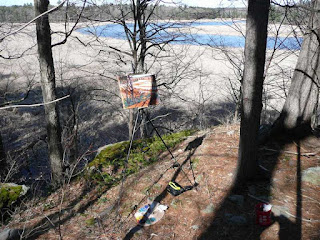
I am sure that some property owners think the word in the title should be "damn". It fits according to both the dictionary and the landowners wanting the industrious beaver condemned by God to suffer eternal punishment in hell.
I like beavers. We all need a place to live. I used the word to mean a barrier constructed to hold back water and raise its level. The resulting reservoir is used in the generation of of a beaver's family and not electricity. The beaver lodge is clearly evident in the Google Earth image. I painted the beaver lodge in #1734 "Long Lake Outlet" a month previously.
There were indications that someone was trapping the beavers. I am no trapper but I could read the signs. Someone had breached the dam and the spring flood was pouring over the top. There were also some steel posts embedded nearby probably securing underwater traps. I do know that this particular dam had let go in the past and flooded out Black Rapids Road at its lowest point.
The reflected colours of the spring forest in the beaver reservoir attracted me to this scene. The colours of the overflow were also distinctly different. This is were the Prussian and phthalo blues really come into play to achieve those special blends of pigment. I remember the drumming of ruffed grouse and the gobbling of a harem of turkeys bit I did not see any sign of beavers.
I would visit the same location twenty-three days later in #1761 "Long Outlet".









































